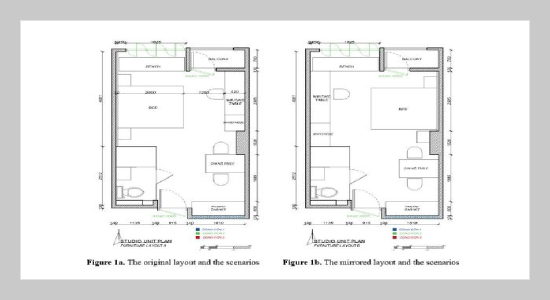1Petra Christian University, No.121-131, Siwalankerto, Kec. Wonocolo, Kota SBY, Jawa Timur 60236, Indonesia
Received:
December 9, 2020
Accepted:
March 17, 2021
Publication Date:
July 19, 2021
Copyright The Author(s). This is an open access article distributed under the terms of the Creative Commons Attribution License (CC BY 4.0), which permits unrestricted use, distribution, and reproduction in any medium, provided the original author and source are cited.
Download Citation: ||https://doi.org/10.6180/jase.202202_25(1).0014
ABSTRACT
After Covid-19, residential has become the main space for every activity, including work, education, and leisure. Therefore, comfort in residential space is crucial to the occupant. As researchers have found traces, that the virus is airborne, the air quality in the residence must be highlighted, especially for people who live in a centralized cooling system residence. When the cooling system is well maintained, there is no significant risk of viral transmission, but not all residential building has HEPA-filters, nor a well-maintained system. This research focuses on the studio room apartment unit, as it has the smallest opening area compared to other room types. A small one-sided opening is not ideal for the wind to move throughout the room. A few design suggestion is simulated under three air-flow speed, to prove that natural ventilation is possible to be adapted, to reach comfort while minimizing the risk of viral transmission. The result is, the indoor wind speed can be enhanced the most at the overall unit area by modifying the fixed window to an operable window, giving upper horizontal opening in the wall across the existing opening, and using gauze doors on both door openings. The furniture layout is proved to affect wind distribution in the room. This research can also serve as an alternative strategy to optimize the use of natural ventilation to decrease energy use for cooling in the tropic area, after the pandemic.
Keywords:
Design adaptation; Indoor airflow; Viral transmission
REFERENCES
- [1] Felipe Ornell, Jaqueline B. Schuch, Anne O. Sordi, and Felix Henrique Paim Kessler. “Pandemic fear” and COVID-19: Mental health burden and strategies. 42(3):232–235, 2020.
- [2] Grazia Maugeri, Paola Castrogiovanni, Giuseppe Battaglia, Roberto Pippi, Velia D’Agata, Antonio Palma, Michelino Di Rosa, and Giuseppe Musumeci. The impact of physical activity on psychological health during Covid-19 pandemic in Italy. Heliyon, 6(6), 2020.
- [3] Shuai Liu, Lulu Yang, Chenxi Zhang, Yu-Tao Xiang, Zhongchun Liu, Shaohua Hu, and Bin Zhang. Online mental health services in china during the covid-19 outbreak. The Lancet Psychiatry, 7(4):17–18, 2020.
- [4] J Woods, NT Hutchinson, SK Powers, and WO Roberts. The COVID-19 pandemic and physical activity. Sports Medicine and Health Science, 2:55–64, 2020.
- [5] Jon Brassey, Carl Heneghan, Kamal R Mahtani, and Jeffrey K Aronson. Do weather conditions influence the transmission of the coronavirus (SARS-CoV-2). Oxford COVID-19 Evidence Service, 2020.
- [6] Francesco Chirico, Angelo Sacco, Nicola Luigi Bragazzi, and Nicola Magnavita. Can air-conditioning systems contribute to the spread of SARS/MERS/COVID-19 infection? Insights from a rapid review of the literature. International Journal of Environmental Research and Public Health, 17(17):1–11, 2020.
- [7] Leslie Dietz, Patrick F. Horve, David A. Coil, Mark Fretz, Jonathan A. Eisen, and Kevin Van DenWymelenberg. 2019 Novel Coronavirus (COVID-19) Pandemic: Built Environment Considerations To Reduce Transmission. Applied and Environmental Science, 5(2), 2020.
- [8] Morawska L, Tang JW, Bahnfleth. How can airborne transmission of COVID-19 indoors be minimised? Environment International, 142:105832, 2020.
- [9] Surabaya Statistic Department. Statistik Daerah Kota Surabaya 2020, 2020.
- [10] Climate Surabaya. Meteoblue, 2020.
- [11] A Bhatia. HVAC-Natural Ventilation Principles.
- [12] Ahana Sarkar and Ronita Bardhan. Improved indoor environment through optimised ventilator and furniture positioning: A case of slum rehabilitation housing, Mumbai, India. Frontiers of Architectural Research, 9(2):350–369, 2020.
- [13] K. W. Cheong and E. Djunaedy. Technical note: The influence of furniture and equipment layouts on airflow pattern in a clean room. Building Service Engineering, 22(4):261–266, 2001.
- [14] H. Frick, A. Ardiyanto, and A.M.S. Darmawan. Penyegaran udara dalam gedung. Ilmu Fisika Bangunan, 4th edition, 2011.
- [15] Badan Standarisasi Nasional. SNI 03-6572-2001 Tata Cara Perancangan Sistem Ventilasi dan Pengkondisian Udara Pada Bangunan Gedung. 2001.
- [16] Michael Herf. How to Ventilate for COVID-19.
- [17] Sauermann. Air change rate: a vital measurement in the fight against COVID-19.









